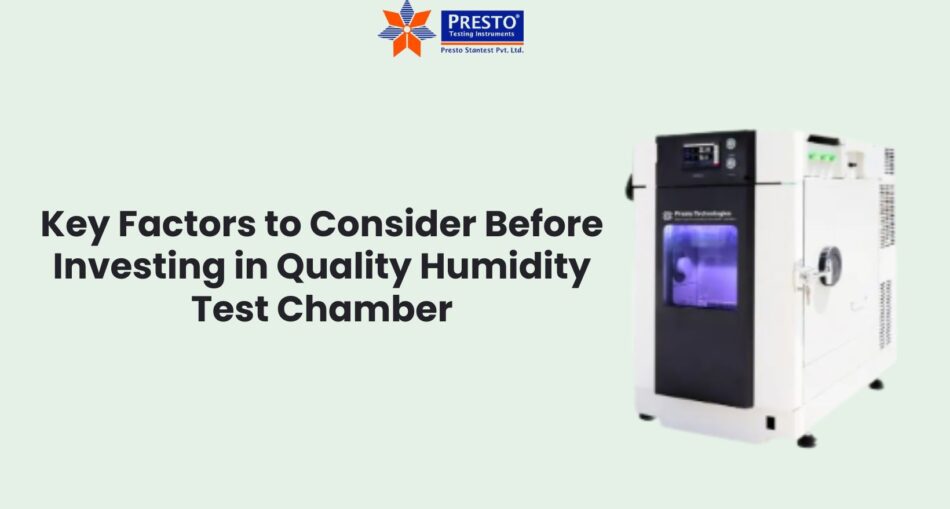When it comes to quality assurance and product durability testing, a humidity chamber plays an essential role in simulating environmental conditions like moisture and temperature. Whether you’re in the electronics, pharmaceutical, textile, or automotive industry, using a humidity chamber helps in understanding how products will perform in real-world conditions. However, investing in this testing equipment is not a simple decision.
There are various types of humidity chambers available on the market, each with different features, sizes, capabilities, and price points. Therefore, before making a purchase, it’s crucial to evaluate several factors to ensure the chamber meets your specific requirements. This blog post will guide you through the top considerations to keep in mind before buying a humidity chamber, so you can make an informed decision and get the most value for your investment.
Understand Your Application Needs
Before you even look at models or features, take time to clearly define what you’ll be using the humidity chamber for. Different industries require different testing environments, and your intended application will directly influence the chamber’s specifications.
- Are you testing materials, electronics, or finished products?
- What range of temperature and humidity levels do you need?
- Will the chamber be used for research, quality control, or product development?
Identifying these requirements upfront will help narrow down your options and prevent overspending on features you don’t need.
Chamber Size and Capacity
One of the most practical considerations is the size and internal capacity of the humidity chamber. The right size will depend on the number and size of the test samples you plan to use regularly.
If your products are bulky or if you’re running multiple tests at once, a larger chamber may be necessary. On the other hand, a compact benchtop model might be sufficient for small-scale testing or limited lab space. Always factor in future growth—buying a slightly larger chamber today could save you from needing to upgrade later.
Control Accuracy and Stability
For precise testing, your humidity chamber must offer excellent control over both temperature and humidity settings. Minor fluctuations can affect test results and compromise data integrity, especially in regulated industries.
Look for chambers that include PID (proportional-integral-derivative) controllers or advanced touchscreen control panels that allow for fine-tuned settings. Stability and uniformity across the testing environment are also crucial, especially when testing sensitive materials.
Build Quality and Material
The durability of a humidity chamber depends heavily on the materials used in its construction. A well-built chamber reduces maintenance costs and ensures a longer service life.
Chambers with stainless steel interiors are often preferred due to their resistance to corrosion, especially in high-humidity environments. Insulation quality, door sealing, and structural design also contribute to performance and longevity.
Energy Efficiency and Noise Levels
In many lab or manufacturing environments, energy efficiency is a key consideration—not only for environmental reasons but also for cost-saving. Additionally, low noise levels are beneficial in workspaces that require quiet.
Some chambers offer eco-friendly features such as efficient compressors or standby modes when not in use. Before purchase, check energy ratings and user reviews about operational noise to make sure they align with your facility’s expectations.
Ease of Use and Maintenance
Usability should not be overlooked. A chamber that’s difficult to operate or clean will slow down your workflow and increase downtime. Choose models that offer intuitive controls and easy access for routine maintenance.
Features like programmable cycles, automatic humidity generation, and self-diagnostic systems can significantly reduce the need for manual intervention. Also, consider whether spare parts and service support are readily available in your region.
Compliance and Certifications
Depending on your industry, your humidity chamber may need to meet specific compliance standards. This is especially true in pharmaceutical, aerospace, and electronics sectors where international testing norms apply.
Ensure the model you’re considering is compliant with relevant ISO, ASTM, or ICH guidelines. Certified chambers not only meet quality standards but also simplify audits and regulatory approvals.
Budget and Humidity Chamber Price
Finally, let’s talk about one of the most important considerations- humidity chamber price. The price can vary widely depending on the chamber’s size, features, brand, and control systems. While it may be tempting to go for the most affordable model, it’s crucial to weigh price against long-term value.
Investing in a slightly higher-end model with better performance and durability may save you money in the long run due to lower maintenance costs and reduced downtime. Always request quotes, compare models, and consider the total cost of ownership, not just the initial price tag.







